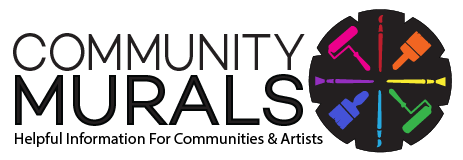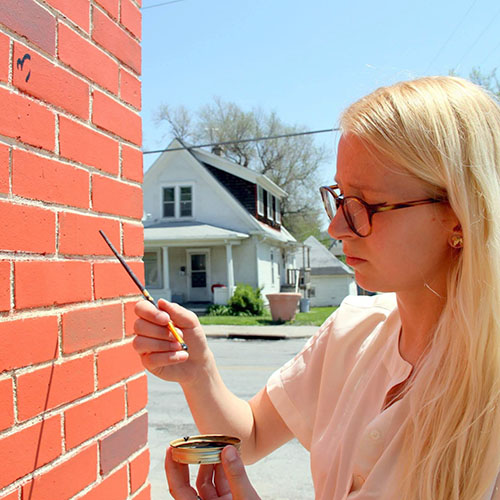1. Please state your name, business name and your current working area (how far are you willing to travel for work). Maggie Weber, Magdalena Murals, Dependent upon nature of the job.
2. Do you define yourself as a muralist or simply as an artist? I consider myself to be a muralist because that is the work I prefer and pursue most often in the form of commissions, grants, and public projects.
3. What other types of art do you make? Oil paintings on canvas, jewelry, watercolors.
4. What inspires your artwork when content is not dictated by a client? My work is inspired by my dreams, life changes, feminism, and photographs I’ve taken. There is a stark contrast in style and color between my personal work and my public murals. The oil paintings I create for myself and exhibit in galleries are often very moody and dark. I’m influenced by the baroque movement and chiaroscuro lighting. My watercolors tend to have both surrealist and art nouveau elements.
5. What was the path that led you to make murals with communities? Was it intentional or did it happen via requests from community? In 2009, I was a student in the Kent Bellows Mentoring Program (KBMP), and I was lucky to be placed in the summer Mural Arts class. We created a 100 ft mural on Leavenworth Street with input from residents in the neighborhood. This was my first experience painting outside for extended periods of time as well as interacting with the public while working. From there, I submitted a design for the Benson Mural Project that took place in 2010 and my design was selected. During this project, I learned how to use a lift. Since then, I have taught many semesters for KBMP, completed 13 community mural projects, and many other privately commissioned murals and hand painted signs.
6. Can you recall a specific moment (or moments) that helped you realize you wanted to be a part of making murals with communities? In 2013, with the help of my friend Julie Smith, I organized what I consider to be my first authentic community mural. This process involved raising money, scouting a location, bringing artists together, meeting with a neighborhood association, knocking on doors, and putting calls out for public input. We were lucky to work in the Gifford Park neighborhood because they already had a strong sense of community spirit, and welcomed a public mural with open arms.
7. What are the benefits of collaborating with a community to you as a person, as an artist?Creating public art really challenges me to think critically about every aspect of my work and how it will impact the people who interact with it. I believe it makes me a more empathetic person. I feel privileged to have opportunities to meet the people who make their communities unique whether I’m speaking to business owners, families, children, teachers, nonprofit leaders, etc.
8. What do you perceive as being the benefits to the communities (to paint a mural)? Perhaps there are different kinds of benefits during the process vs after the mural is complete? Murals allow communities to discover a cohesive interpretation of what makes them unique from others. Statistically, there are less instances of crime and vandalism in areas that have public art. This means there is more time for the community to focus on improvements rather than cleaning and repairing. When people take pride in the area they reside, they tend to take care of it.
9. What are some key differences in working with a community client versus working with a commercial business or homeowner? Community work is very involved. From fundraising by writing grants or crowdfunding to sorting through hundreds of surveys to organizing public paint days to determining what is fair for folks to volunteer for and what should be compensated, there is a lot of work to do. Commercial work is as straightforward as you make it. Typically, the client will have a design in mind or they want you to make one and this determines price. From there, I will decide if it’s a project I want to take on. If so, I will draft a contract and send it over to solidify the timeframe and price. The key differences I see are: how the project is funded and who manages that, who has the final say on imagery, and how many people physically work on the project.
10. What is your typical process of collaborating with members of a community? Have you developed helpful strategies for working with communities or is each community so different that each one ends up with its own process? For each community project, I follow a guide I created:
How to Make a Mural: A Step by Step Process
- Goal – Purpose – Intention / Why?
- Intended Audience / Demographic
- Location / Interior or exterior / Consider visibility
- Funding / Grant, private sponsor, commission, crowdfunding
- Community Input (If applicable) / What is appropriate to incorporate in this public piece
- Brainstorming & Idea Pooling / List potential subject matter / Combine ideas
- Sketch / Multiple rough sketches
- Design / Finalized design to scale (if possible)
- Prep / Scrape wall, Power wash (If needed)
- Prime / Completely cover surface
- Transfer / Project Image, Grid, or Freehand / Material: Chalk, Crayon, or Paint
- Color Blocking /Main colors, background
- Details / Shading, textures
- Outline / Define edges, contrast
- Touch-Ups / Any smudges, smears, mistakes
- Document / Photograph, promote, share
11. What challenges have risen in the process, what have been the solutions? Within every community, there are members with differing opinions. This is inevitable, and I’ve found that including the ideas of outspoken individuals usually puts out most fires even if it is something very small within the larger composition.
12. How have communities found you? Or do you seek them out? If you seek them out, how do they typically respond? Most groups find my work via word of mouth recommendations and Google searches.
13. What are your favorite aspects of being part of community murals? I love when people come up to me and describe the way my artwork has impacted their daily commute or the way they see their neighborhood as a more beautiful and unified place to live after a mural has been installed. Its great to be a part of something that brings so many people intense feelings of joy and neighborhood pride.
14. What is your dream project? I couldn’t say, but I feel like I get closer every time I push the boundaries of what I think I know about painting murals.
15. What is your advice to artists who aspire to be a muralist? Don’t sell yourself short. If there is a will to create it, there is a way to pay for it. If a client says your initial bid is too high, suggest creating a smaller mural. Never work for free. Your time and talent are worthy of compensation. I limit the number of times I will change a design from the time of commissioning, and that’s something I recommend to people new to this world. If I’m not really feeling a connection to the project from the beginning, I respectfully decline the commission. If you are creating a mural for a portfolio piece, consider the following elements when selecting a wall: visibility, walkability in a neighborhood, traffic patterns, and the condition of the physical wall. Learn about the chemistry in the materials you are working with. Is this wall best suited for exterior acrylic latex or enamel paint? If you are creating a mural in a daycare, will there be hundreds of tiny hands touching the wall each month? Will there be the potential for aspiring tiny artists to create crayon landscapes on top of your mural? If you are painting in a restaurant, consider grease and general wear and tear. Research your primers and topcoats. There is nothing worse than spending months on a project just to see it deteriorate after one rain shower or one winter.
16. What is your advice to artists who aspire to paint community-based murals? It’s really important to spend quality time in the community in which you are installing your artwork. I don’t necessarily think murals that are inspired by community ideas have to look like a collage, but they can absolutely be a collage of symbolic concepts that represent the people residing in the area. Consider the fact that you might not be equipped to convey a message that will be popular with all residents of the neighborhood. Bring in artists with relevant lived experiences to help you. Pay them for their time. Obviously, there are a lot of factors that go into creating a successful community mural. The best thing you can do for your project is to be vulnerable and ask tough questions when you are in the initial planning stages.
17. What is the best way for communities to contact you? I prefer an introduction to people and projects via email:
maggiejaneweber@gmail.com.
www.maggieweber.com
FB – Magdalena Murals
IG – @magdalenamurals

